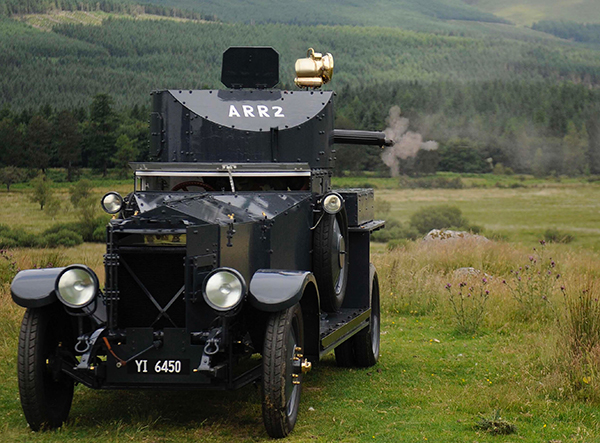British Army armoured cars in the War of Independence
Published in Artefacts, Issue 4 (July/August 2021), Volume 29By Lar Joye
The War of Independence was fought in three phases. From 1918 to 1919 there were small-scale attacks on the police, with the destruction of minor outposts and assassinations of policemen. Until October 1920 there were larger-scale attacks on police stations, and during the summer of that year the Black and Tans and Auxiliaries arrived. The final and most violent period began in November 1920 with the establishment of the active service units or flying columns—and, in the case of the Crown forces, with greater use of armoured trucks and cars.
Two types of armoured car were used in Ireland. The Rolls-Royce (1920 pattern) armoured car was based on the famous civilian Silver Ghost chassis, had a crew of four and weighed only 3.8 tons. Equipped with pneumatic tyres, it could travel country roads at a maximum speed of 20mph with what was then regarded as a ‘quiet’ engine, and it carried a Vickers machine-gun and 3,000 rounds of ammunition. By April 1921 there were 31 of these vehicles in Ireland. The Peerless armoured car was based on the American Peerless Truck chassis; at six tons it was heavier than the Rolls-Royce and slower, with a maximum speed of 18mph. By April 1921 there were 70 Peerless armoured cars in Ireland and they were restricted to better roads in urban areas. Its advantage, however, was that it had two turrets with French Hotchkiss machine-guns carrying over 3,500 rounds of ammunition and a crew of five.

Above: The Irish Defence Forces’ surviving Rolls-Royce armoured car, ‘Sliabh na mBan’, one of thirteen armoured cars handed over by the British Army in 1922. (Curragh Military Museum)
The arrival of armoured cars, particularly in urban areas, could prove disastrous for the IRA. Members of the 3rd Battalion of the Dublin Brigade on patrol on Great Brunswick Street on 14 March 1921 were surprised by the arrival of two Crossley Tenders and an armoured car, which fired its machine-gun. In the resulting battle the IRA lost three killed and two captured, while Crown forces lost two. Despite the fearsomeness of the vehicles, on 14 May 1921 the Squad stole a Peerless armoured car to go to Mountjoy jail posing as British soldiers in an attempt to release Seán MacEoin. (See ‘100 Years Ago’, HI 29.3, May/June 2021.) The operation was not successful but it demonstrated the audacity of the Squad.
Lar Joye is Heritage Officer of Dublin Port.
















